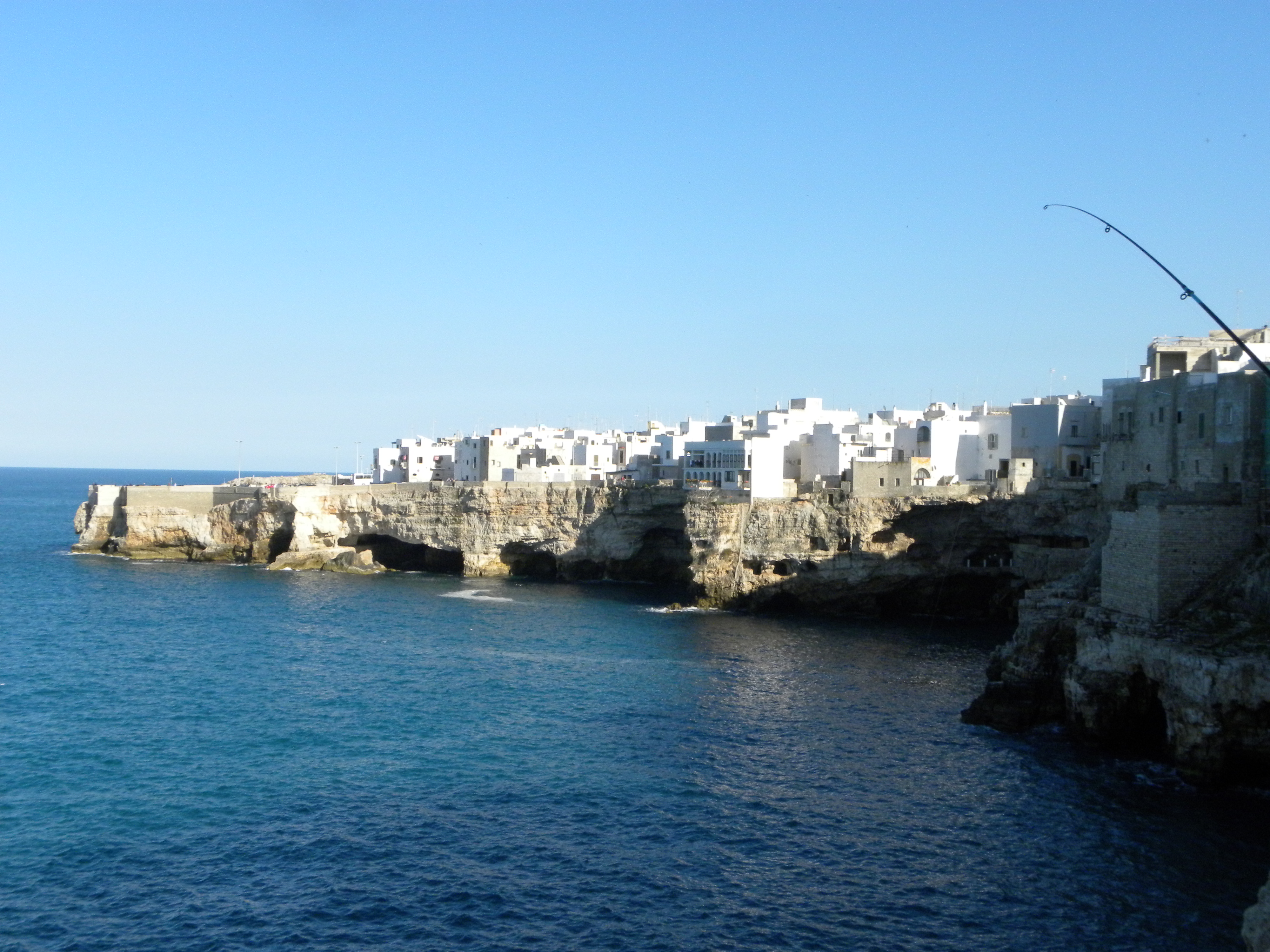Saturday: Bari
Bari, county seat, is the one of the biggest city of the South. It is famous for the remains of St. Nicola, (stolen to Turks one thousand years ago) kept in the church. Bari has been always a crucial point as for trade and as for political- cultural relationships with the Eastern Europe and Middle East. There are also lots Byzantine and Romanesque churches in the old town, the longest seafront of Italy and the Theatre Petruzzelli in the heart of Murat neighbourhood.
Sunday : Trani, Castel del Monte, Ruvo di Puglia
Morning: tour of the old town of Trani and Castel del Monte.
Trani is placed on the Adriatic coast near a little inlet, which is the actual port that comes from the mouth of a river, today disappeared. A level landscape characterized by plantations of olive groves and vineyard encloses Trani. The subsoil is famous for the extractive activity of so-called “Pietra di Trani”, which has always represented a richness for the city. It is a kind of limestone, indeed the subsoil of Trani represents the most important deposit in Apulia. This kind of stone has an ivory shade of bottom on which one can find red or yellow striping and veining. It was widely for many centuries; nowadays it is employed in every kinds of civil constructions and in architecture.
CASTEL DEL MONTE: Universally known for its unique octagonal form, for its symbolic suggestions and (known) to be the most mysterious among the buildings on order by Federico II of Swabia, Castel del Monte represents one of the most important tourist destinations of Apulia. Built in the XIII century it has become Unesco heritage in 1996. The historians consider it an excellent building, congenial to Federico’s life who considered Apulia the ideal place to carry out the assignments of the State and to release his passions: hunting, love and good cuisine. The Cathedral of Ruvo di Puglia, dedicated to St. Maria Assunta, is the one of the most important examples of Apulia Romanesque style. It was built between the XII and the XIII century with different following adjustments. In the ancient building, nowadays called Jatta Museum, perfectly preserved, dating back to 1848, there is a rich collection of objects dating back to VII-VI century BC, which show Pre Roman Apulia people’s life and their activities; moreover, there are anthropomorphic vases, some Apulia amphora and a proto-italic craters.
The Church and the St. Magno’s necropolis.
St. Magno’s church (XII century), typical example of rural architecture, in the area there is a necropolis of graves, which expands for around 2 km. It consists of about fifty circular graves with a basket of four megalithic blocks at the heart, dating back to the Bronze Age, where have been recovered many bronze and iron objects.
Monday: Altamura, Pulo di Altamura, Matera.
ALTAMURA: : famous in Italy thanks to the bread DOP, typical for its shape (in jargon skuanète, translation high), Altamura has an old town very nice, the most important monument is the Santa Maria Assunta Cathedral, an example of Apulia Romanesque, gothic style (XIII century).
PULO DI ALTAMURA
The “Pulo”is a wide hole of sinking, which formed because of erosion and sinking of a vault of a big subterranean cave. It has a circular structure with a diameter between 450 and 500 metres, a perimeter of 1800 metres and a depth between 70 and 90 metres. In the depression, widely covered by Mediterranean scrub and herbaceous vegetation, one can go down through a little path, which winds in the eastern side among ferula, asphodels, terebinth and blackthorn. On the northern edge there are lots caves which have represents a shelter for many people since the high Palaeolithic age. The karst area is populated by different birds of prey (hawks, kestrels, buzzards), which use the ravine among the rocks as a dormitory or to build a nest. In Lamalunga (a small town) one can possible meet the “Uomo di Altamura” (Homo Arcaicus). Nearby the visitors’ centre, expert speleologists will carry you to discover this intact specimen of Neanderthal individual dating back to 60000 years ago.
MATERA: Matera is called also “city of Sassi”, for the peculiarity and the uniqueness of its old town. It is the most ancient residential complex; it is built by mined houses close to tuff rock “Gravinella”. The “Sassi” has been recognized Heritage of Humanity by the UNESCO in 1993, it is the first site of the southern that has received this recognition and ( Sassi) represent one of the most ancient and better preserved example of bio-architecture in the world.
Tuesday
POLIGNANO a MARE: the guided tour will place on a cliff characterized by caves in which Polignano a Mare arises. It is a beautiful town, homeland of Domenico Modugno. Our tour starts from the statue of this famous singer. Crossing the bridge of the ancient Traiana Avenue and the alleys rich of history, flowers and poetry, the tour brings to the terraces on the seaside with a breath-taking view. Santa Maria church, set in the square Vittorio Emanuele, has an architectonical importance. The tour follows white houses placed on calcareous rocks, full of caves modified by the sea: Rondinelle Cave, Grottone Cave, Palazzese Cave and Ardito Cave are the most famous.
MONOPOLI: on the coast, near Valle d’Itria, there is Monopoli. The old town has medieval origins, which is surrounded by walls, white houses; courtyards decorated by flowers just outside there are inlets of white sand.
Wednesday
ALBEROBELLO: in the centre of Valle d’Itria there is Alberobello, a famous town born in the XIV century. It is characterized by stone buildings, called “Trulli”, that are heritage of the UNESCO since 1996.
CASTELLANA GROTTE: Castellana Grotte are an agglomerate of subterranean caves (karst origins) of touristic importance; they are the most beautiful caves of Italy. These caves have 3348 metres of length and 122 metres of depth from the surface on the upland, which was created in the Higher “Cretaceo”, around 90/100 million years ago.
Thursday
LECCE: in Apulia Lecce is the Baroque capital, where there are many amazing churches with anthropomorphic sculptures. The cathedral, the Roman amphitheatre, Santa Croce church, the handcrafted workshops of papier-mâché and the baronial buildings… All of this and more awaits you in Lecce!
Friday
OTRANTO PORTA D’ORIENTE
The UNESCO has recognized “the Old Town of Otranto” as a cultural heritage since “Announcing site of Peace”.
From the beautiful seafront, we can see the mountains of Albania. Passing through the majestic “Porta Alfonsina”, we can come in the Old town, where it is possible to visit the Aragonese Castle and the Cathedral with the precious mosaic floor, which represents the Tree of Life and the chapel with the remains of the 800 martyrs, murdered by Turks in 1480.
GALATINA
In the old town of Galatina, Santa Caterina d’ Alessandria Church is a casket of art, which keeps magnificent frescos and blends several architectonic styles, from the Romanesque to the Gothic, from the Norman to the Byzantine. This church has a Romanesque façade with an extraordinary rose window and a Gothic interior, frescoed on request of the princess Maria D’Enghien, who in the XV century called the best artists of Naples to realize pictorial series comparable to those of Assisi.






